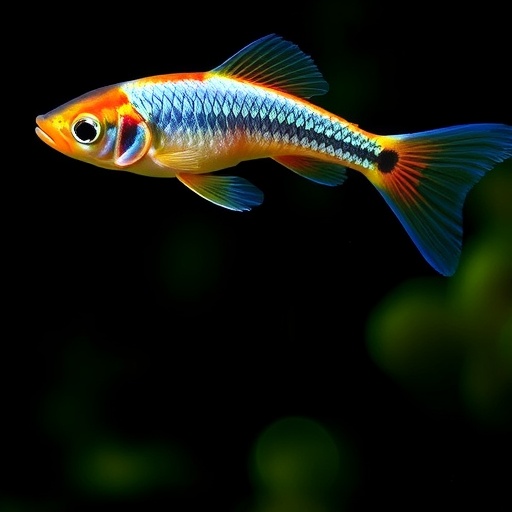In recent years, the increasing prevalence of synthetic dyes in our environment has raised significant concerns regarding their impact on aquatic life. One such dye, rhodamine B, is widely used in various industries, including textiles and food production. A compelling study conducted by Mamangam and Brimson delves into the effects of rhodamine B on the neuronal behavior and physiological function of the F1 generation of the popular model organism, Danio rerio, or zebrafish. This research not only highlights the neurotoxic potential of rhodamine B but also underscores the importance of studying environmental pollutants and their long-term effects on the ecosystem.
Danio rerio has emerged as a crucial model organism in toxicology due to its genetic similarity to humans and transparent embryos, which allow for real-time observation of developmental processes. The study focuses on the F1 generation, which is particularly critical, as this generation is the direct offspring of parents exposed to rhodamine B. Thus, understanding how these exposures influence their physiological capabilities is vital for assessing environmental and health risks.
The research indicates that exposure to rhodamine B can lead to significant alterations in neuronal behavior. The authors observed notable changes in locomotor activity and social interaction among the exposed zebrafish. Such behavioral changes can serve as indicators of neurotoxic effects and may suggest underlying disruptions in neural functioning. The implications extend beyond just the zebrafish; they foreshadow potential impacts on higher trophic levels within aquatic ecosystems.
Physiological assessments in the study revealed alarming results concerning the survival rates and reproductive success of the F1 generation. The research suggests that rhodamine B not only affects individual behavior but can also have far-reaching consequences for population dynamics. This is particularly troubling when one considers the role of zebrafish in aquatic food webs and their use in research concerning human health.
Neurotoxicity is a pressing issue in environmental sciences. The study’s results provide a significant contribution to understanding how even trace amounts of synthetic compounds can have detrimental effects on brain function. The alterations in central nervous system function as seen in zebrafish may serve as a model for similar effects in other species, including humans. This aspect lends a sense of urgency to regulatory agencies seeking to mitigate exposure to toxic substances.
The implications of this research extend to broader environmental policy discussions. As communities grapple with pollution, decisions made regarding the regulation of chemical products must incorporate findings such as those from Mamangam and Brimson’s study. The resemblance between the neural pathways of zebrafish and humans emphasizes the need for caution when introducing synthetic dyes into consumer products, particularly those that interact with water systems.
Moreover, the study opens a dialogue about the necessity for more stringent measures concerning the disposal of industrial dyes. With many countries facing challenges related to wastewater management, an immediate response is warranted. This study acts as a clarion call for industries to assess their practices and consider more sustainable alternatives that do not compromise aquatic life or human health.
Another critical aspect of the research is its revelation regarding the cellular and molecular mechanisms by which rhodamine B induces these neurotoxic effects. As the study detailed the biochemical changes within the zebrafish exposed to the dye, it provided insights into oxidative stress and potential neuroinflammatory pathways engendered by rhodamine B. Understanding these mechanisms is vital for developing targeted interventions and remediation strategies to address and reverse such toxic effects.
Building upon existing literature, the findings contribute to a growing body of evidence that challenges the perception of certain chemicals as innocuous, especially in the context of chronic exposure. Policymakers and environmental organizations must respond to this scientific knowledge by instituting robust standards that safeguard both natural habitats and human systems.
Furthermore, the study raises critical questions regarding the long-term viability of aquatic ecosystems in the presence of pollutants like rhodamine B. As populations of aquatic organisms decline due to exposure to hazardous substances, the balance of entire ecosystems is thrown into disarray. Such disruptions can lead to the loss of biodiversity, which has cascading effects on environmental sustainability and public health.
In conclusion, the study on rhodamine B’s effects on Danio rerio is not merely an academic exercise; it has real-world implications that can influence public health policy and environmental regulations. By shedding light on the profound influence of synthetic dyes on aquatic life, Mamangam and Brimson contribute to the urgent dialogue surrounding environmental toxicology. As we move forward, embracing a precautionary approach and advocating for sustainable practices is essential in preserving the integrity of our ecosystems.
Public awareness about the potential risks associated with chemical exposure is equally critical. Increased public understanding can pressure industries to adopt safer alternatives, thereby ensuring a healthier environment for future generations. The responsibility lies with both scientists and society to foster a culture that prioritizes sustainability and ecological mindfulness, paving the way for future research and policy changes that prioritize the health of our planet.
Lastly, the call for enhanced research initiatives is paramount. Continued investigation into other synthetic dyes and their long-term effects on various species will be vital. Only with comprehensive knowledge can society effectively combat the pervasive issue of environmental pollution and its extensive repercussions.
Indeed, the study detailed here is not simply an isolated contribution but part of a larger movement towards environmental accountability, where the precedence of sustainability must be our guiding principle.
Subject of Research: The effects of rhodamine B on neuronal behavior and physiological functions in zebrafish.
Article Title: Effects of rhodamine B on neuronal behavior and physiological function in the F1 generation of Danio rerio.
Article References:
Mamangam, S., Brimson, J.M. Effects of rhodamine B on neuronal behavior and physiological function in the F1 generation of Danio rerio.
Environ Sci Pollut Res (2025). https://doi.org/10.1007/s11356-025-36966-4
Image Credits: AI Generated
DOI:
Keywords: rhodamine B, zebrafish, neurotoxicity, environmental pollution, aquatic ecosystems, behavioral science, synthetic dyes, public health.




